Gory Guts: Photos of a T. Rex Autopsy
Tyrannosaurus rex may have gone extinct about 65 million years ago, but that didn’t stop four international experts from diving into a gory and gut-filled autopsy of the giant beast. National Geographic and its scientific collaborators made the fake specimen as realistic as possible, giving the “dead" T. rex 50 serrated teeth, bristlelike protofeathers and even shock-absorbing pads on its feet. [Read a Q&A with a paleontologist star in "T. rex Autopsy"]
On display

T. rex on display in the custom-designed biology lab prior to autopsy. (Photo credit: National Geographic Channels/Stuart Freedman)
Those in charge
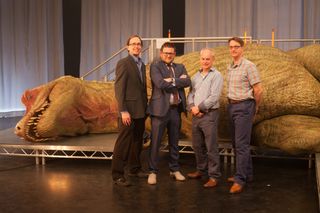
Executive Producers (left to right), Allan Butler (NGC US), Ed Sayer (NGCI), Paul Wooding (Impossible Factual) and the man responsible for the T. rex build, Jez Gibson-Harris (Crawley Creatures) stand before their creation. (Photo credit: National Geographic Channels/Stuart Freedman.)
Awaiting the procedure

T. rex on display in the custom-designed biology lab prior to autopsy. (Photo Credit: National Geographic Channels/Christopher Albert.)
Sign up for the Live Science daily newsletter now
Get the world’s most fascinating discoveries delivered straight to your inbox.
What big claws you have...
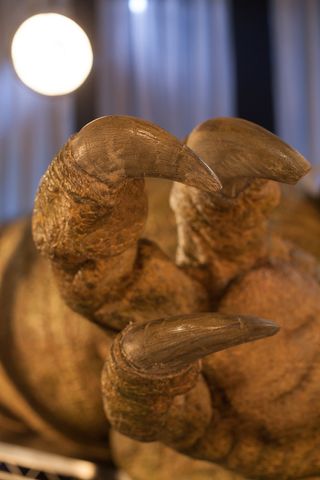
Detail of T. rex claw. (Photo credit: National Geographic Channels/Stuart Freedman.)
Doctors in the house
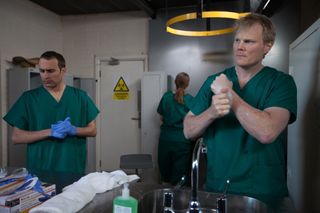
From left to right, Dr. Steve Brusatte, Dr. Tori Herridge and Dr. Luke Gamble scrub in for the autopsy. (Photo credit: National Geographic Channels/Stuart Freedman.)
On a mission
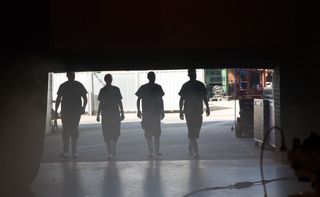
The scientists enter the specially constructed biology lab. (Photo credit: National Geographic Channels/Stuart Freedman.)
Aging the beast
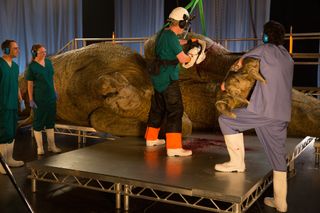
Dr. Luke Gamble takes a chainsaw to the T. rex leg to get a cross section of its bone, from which its age will be extrapolated. (Photo credit: National Geographic Channels/Stuart Freedman.)
An examination
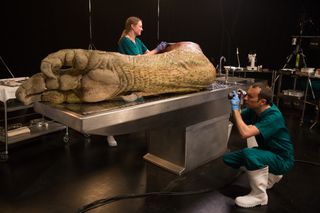
Dr. Tori Herridge examines the severed T. rex leg as Dr. Steve Brusatte photographs the foot. (Photo credit: National Geographic Channels/Stuart Freedman.)
The first cut
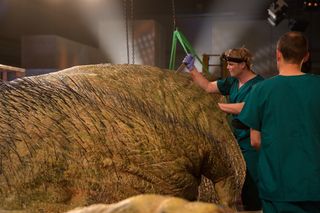
Dr. Luke Gamble makes the first incisions into the T. rex with a blade as Dr. Steve Brusatte looks on. (Photo credit: National Geographic Channels/Stuart Freedman.)
Physical labor
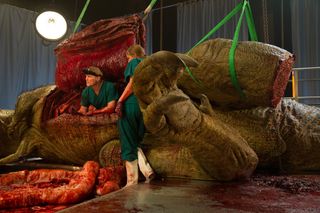
Drs. Luke Gamble and Tori Herridge catch their breath after lifting the T. rex' heavy internal organs out of the body. (Photo credit: National Geographic Channels/Stuart Freedman.)
Reviewing the last meal
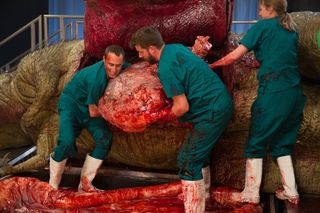
Dr. Steve Brusatte and Matthew T. Mossbrucker lift the T. rex' stomach out of the body. (Photo credit: National Geographic Channels/Stuart Freedman.)
Surveying their work
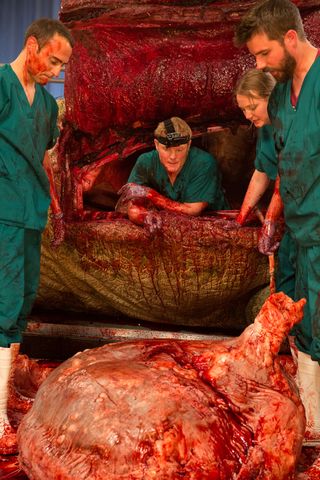
The team, (left to right) Dr. Steve Brusatte, Dr. Luke Gamble, Dr. Tori Herridge Matthew T. Mossbrucker, have removed the T. rex' stomach. (Photo credit: National Geographic Channels/Stuart Freedman.)
Big chompers
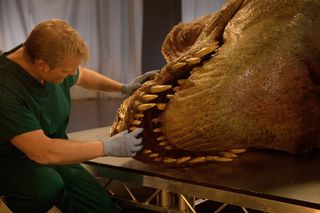
Dr. Luke Gamble examines the T. rex's teeth. (Photo credit: National Geographic Channels/Stuart Freedman.)
Extra large foot

Dr. Tori Herridge and Dr. Steve Brusatte examine the T. rex foot. (Photo credit: National Geographic Channels/Stuart Freedman.)
Discussing the dissection
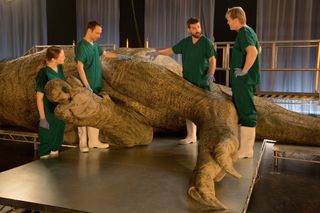
Dr. Tori Herridge, Dr. Steve Brusatte, Matthew T. Mossbrucker and Dr. Luke Gamble examine the T. rex's hind quarters. (Photo credit: National Geographic Channels/Stuart Freedman.)
Opening the animal
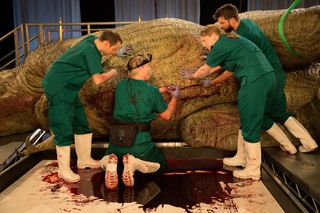
Dr. Luke Gamble slices open the T. rex abdomen with assistance from Dr. Steve Brusatte (left), Dr. Tori Herridge and Matthew T. Mossbrucker (right). (Photo credit: National Geographic Channels/Stuart Freedman.)
Multiple exams at once

Dr. Steve Brusatte and Dr. Tori Herridge examine the T. rex teeth while Dr. Luke Gamble and Matthew T. Mossbrucker examine its gastralia. (Photo credit: National Geographic Channels/Stuart Freedman.)
Dental exam
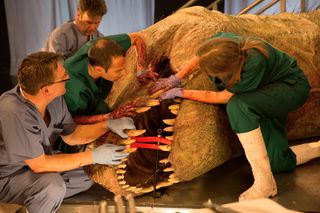
Drs. Brusatte and Herridge examine the T. rex's teeth with a clamp and manual assistance. (Photo credit: National Geographic Channels/Stuart Freedman.)
You don't have the guts

Dr. Luke Gamble hands his colleagues the T. rex's intestines from inside the body cavity. (Photo credit: National Geographic Channels/Stuart Freedman.)
The right doc for the job
Palaeobiologist
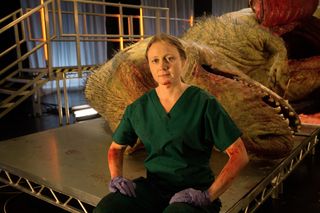
Palaeobiologist Dr. Tori Herridge brings her scientific expertise to bear in T. rex Autopsy. (Photo credit: National Geographic Channels/Stuart Freedman.)
Bringing his knowledge
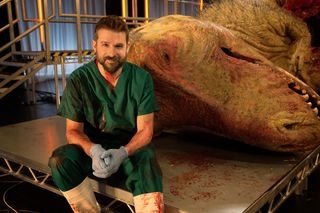
Museum curator and fossil expert Matthew T. Mossbrucker shares his understanding of dinosaurs in T. rex Autopsy. (Photo credit: National Geographic Channels/Stuart Freedman.)
Examining the insides

Dr. Tori Herridge, Dr. Luke Gamble, Matthew T. Mossbrucker and Dr. Steve Brusatte (left to right) separate the T. rex's stomach. (Photo credit: National Geographic Channels/Stuart Freedman.)
What a heart!
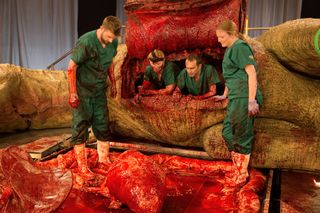
Matthew T. Mossbrucker, Dr. Luke Gamble, Dr. Steve Brusatte and Dr. Tori Herridge (left to right) with the T. rex's removed organs (lung, heart & intestines). (Photo credit: National Geographic Channels/Stuart Freedman.)
Better to see you with

Dr. Luke Gamble and Dr. Tori Herridge prepare to remove the T. rex's eye as Dr. Steve Brusatte and Matthew T. Mossbrucker look on. (Photo credit: National Geographic Channels/Stuart Freedman.)
Tools of the job
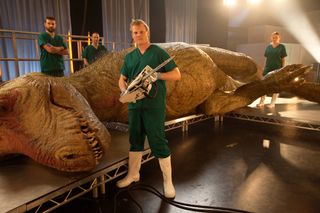
Dr. Luke Gamble with chainsaw as he prepares to cut into the T. rex. Matthew T. Mossbrucker, Dr. Steve Brusatte and Dr. Tori Herridge (left to right) in the background. (Photo credit: National Geographic Channels/Stuart Freedman.)
Getting the details

Drs. Steve Brusatte and Dr. Tori Herridge examine T. rex bone sample. (Photo credit: National Geographic Channels/Stuart Freedman.)
Keeping their distance
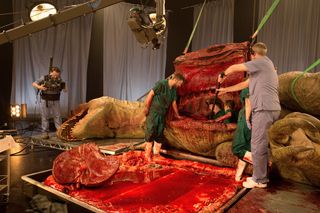
The film crew can't quite follow Drs. Luke Gamble and Steve Brusatte as they examine the T. rex's innards. (Photo credit: National Geographic Channels/Stuart Freedman.)
Dissecting the heart
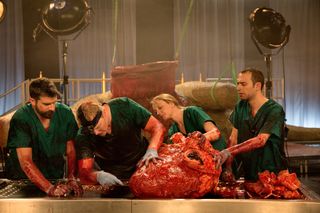
Matthew T. Mossbrucker, Dr. Luke Gamble, Dr. Tori Herridge, Dr. Steve Brusatte (left to right) slice open the T. rex heart. (Photo credit: National Geographic Channels/Stuart Freedman.)
Egg-celent

Dr. Tori Herridge retrieves an egg from the T. rex via its cloaca. (Photo credit: National Geographic Channels/Stuart Freedman.)
Mid-autopsy
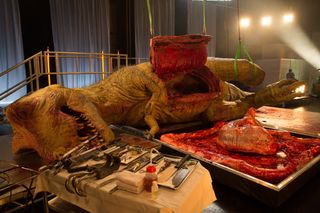
The T. rex's stomach and intestines have been removed. (Photo credit: National Geographic Channels/Stuart Freedman.)
Last meal
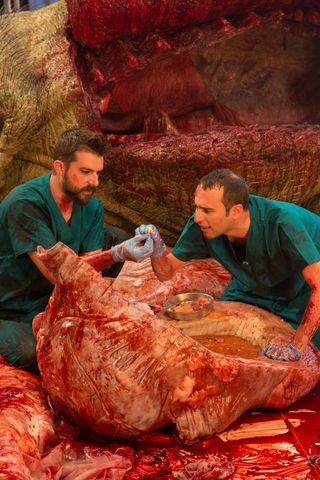
Matthew T. Mossbrucker, left, and Dr. Steve Brusatte examine the contents of the T. rex's stomach. (Photo credit: National Geographic Channels/Stuart Freedman.)
A big-hearted creature
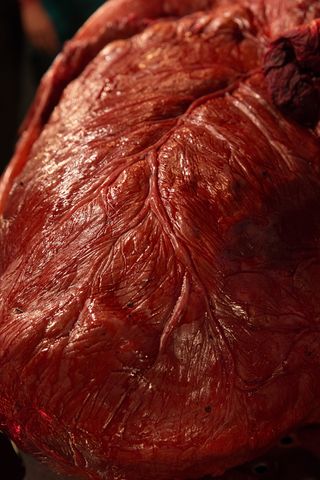
Exterior of the T. rex's heart. (Photo credit: National Geographic Channels/Stuart Freedman.)
Messy work
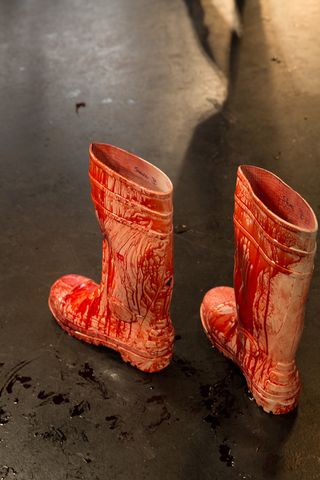
Bloody boots. (Photo credit: National Geographic Channels/Stuart Freedman.)
Dissection of the heart
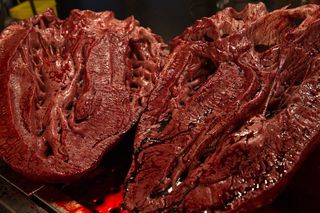
Interior of the T. rex's heart once sliced open. (Photo credit: National Geographic Channels/Stuart Freedman.)
A different perspective
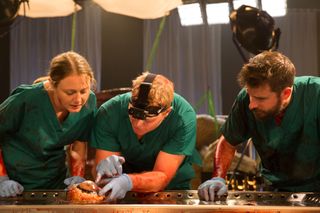
Dr. Herridge, Dr. Gamble and Mossbrucker examine the T. rex's eye following its removal. (Photo credit: National Geographic Channels/Stuart Freedman.)
Another exam
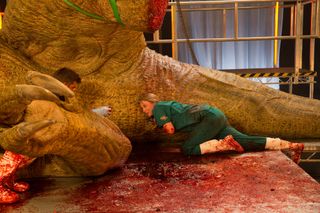
Dr. Tori Herridge reaches into the T. rex's cloaca. (Photo credit: National Geographic Channels/Stuart Freedman.)

Laura is the archaeology and Life's Little Mysteries editor at Live Science. She also reports on general science, including paleontology. Her work has appeared in The New York Times, Scholastic, Popular Science and Spectrum, a site on autism research. She has won multiple awards from the Society of Professional Journalists and the Washington Newspaper Publishers Association for her reporting at a weekly newspaper near Seattle. Laura holds a bachelor's degree in English literature and psychology from Washington University in St. Louis and a master's degree in science writing from NYU.










